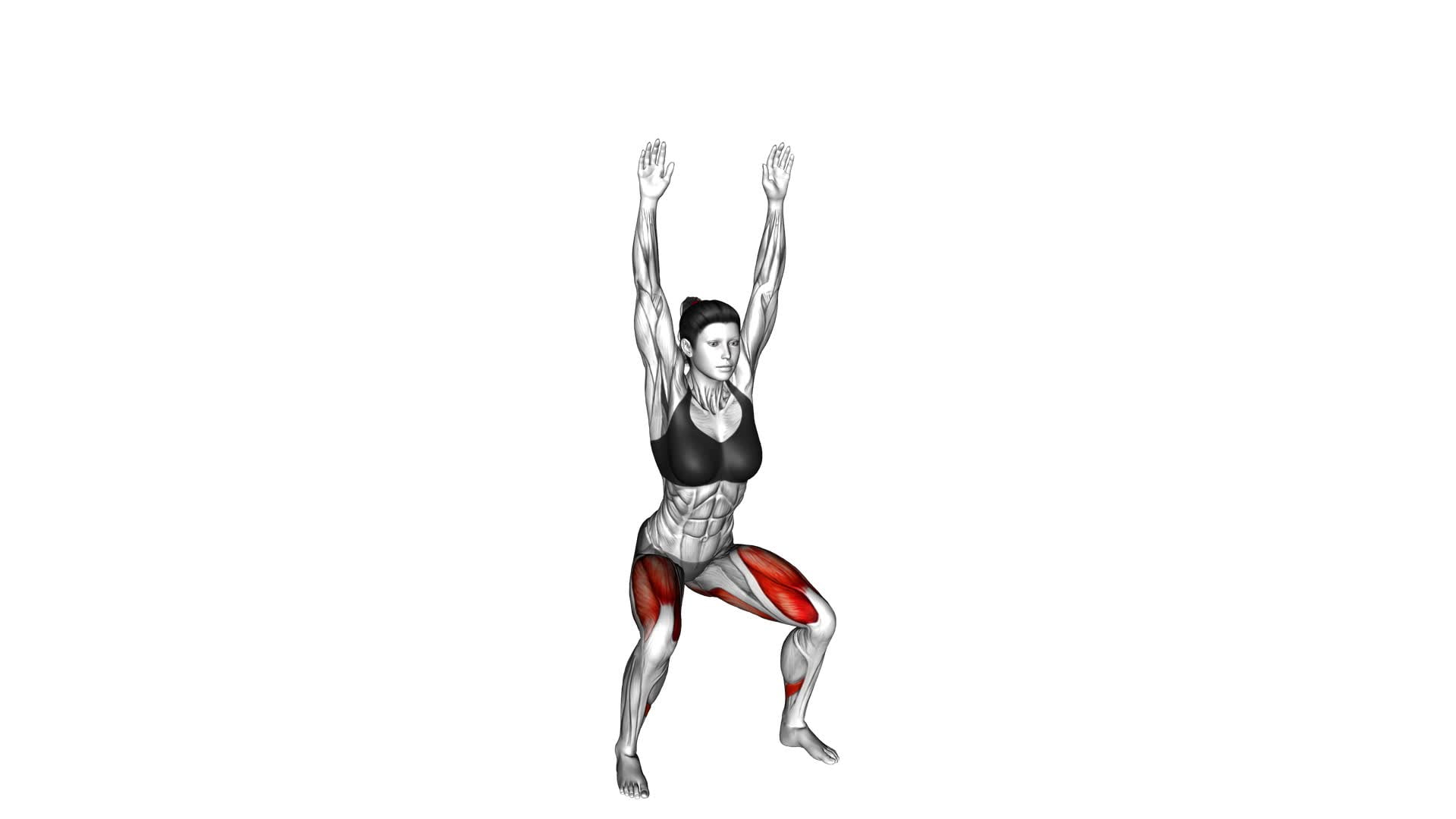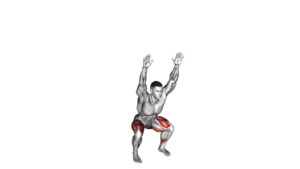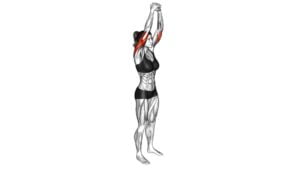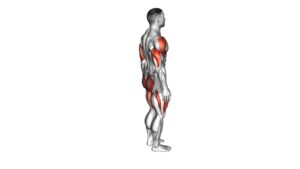Bodyweight Overhead Squat (female) – Video Exercise Guide & Tips

Are you looking for an effective workout that targets your entire body? Look no further than the bodyweight overhead squat.
Watch This Exercise Video
This exercise is perfect for females of all fitness levels. In this video exercise guide, you will learn the proper form and technique, as well as common mistakes to avoid.
With modifications and progressions available, you can tailor the workout to fit your needs.
Get ready to build strength and improve your overall fitness with the bodyweight overhead squat.
Key Takeaways
- Targets multiple muscle groups including quads, glutes, core, and shoulders
- Builds overall body strength and stability
- Improves posture and balance
- Enhances flexibility in shoulders and hips
Benefits of the Bodyweight Overhead Squat
The bodyweight overhead squat offers numerous benefits for women looking to improve their strength and flexibility. This exercise targets multiple muscle groups, including the quads, glutes, core, and shoulders. By performing this squat variation, you can develop greater overall body strength and stability. The overhead squat also helps to improve your posture and balance, as it requires you to engage your core and maintain an upright position throughout the movement.
One of the key benefits of the bodyweight overhead squat is its ability to enhance flexibility. This exercise requires a good range of motion in the shoulders and hips, and by consistently practicing it, you can improve your flexibility in these areas. This can be particularly beneficial for women who may have tightness in these muscle groups due to factors such as prolonged sitting or sedentary lifestyles.
To modify the bodyweight overhead squat, you can start by using a lighter weight, such as a broomstick or resistance band, before progressing to using a barbell. Additionally, you can perform the squat with your feet wider apart to provide more stability and support. As you become more comfortable and proficient with the exercise, you can gradually increase the weight and decrease the width of your stance to challenge yourself further.
Proper Form and Technique for the Exercise
To perform the bodyweight overhead squat with proper form and technique, you need to focus on maintaining a stable and upright position throughout the movement. This is essential for reaping the benefits of squatting properly and avoiding potential injuries.
The overhead squat is an excellent exercise that targets multiple muscle groups, including the legs, glutes, core, and shoulders. By squatting properly, you can develop strength, stability, and mobility in these areas.
One key aspect of maintaining proper form is to engage your core muscles. Your core acts as a stabilizer during the movement, helping to keep your body aligned and balanced. It's important to keep your abdominals tight and your spine in a neutral position throughout the exercise. This not only enhances your performance but also minimizes the risk of strain or injury.
Additionally, as you perform the overhead squat, pay attention to your posture. Keep your chest lifted, shoulders back, and head aligned with your spine. This will help you maintain an upright position and distribute the load evenly throughout your body.
Common Mistakes to Avoid
To ensure proper form and technique during the bodyweight overhead squat, it's important to be mindful of a few common mistakes.
First, make sure your foot placement is correct, as incorrect positioning can lead to instability and compromised form.
Additionally, be sure to engage your core throughout the movement to maintain stability and prevent excessive stress on the lower back.
Lastly, strive for sufficient depth in the squat to fully engage the muscles and reap the benefits of the exercise.
Incorrect Foot Placement
Ensure proper foot placement to avoid common mistakes during the bodyweight overhead squat. Correct foot alignment is crucial for maintaining balance and stability throughout the exercise.
Start by positioning your feet shoulder-width apart, with toes slightly pointed outward. This stance allows for optimal weight distribution, ensuring that the load is evenly distributed across both feet. Avoid placing too much weight on the balls of your feet or the heels, as this can lead to imbalance and potential injury.
Instead, focus on distributing your weight evenly between the balls of your feet and your heels, keeping a solid base of support. By maintaining proper foot placement and weight distribution, you can perform the bodyweight overhead squat with precision and efficiency.
Lack of Core Engagement
One common mistake to avoid during the bodyweight overhead squat isn't adequately engaging your core, which can lead to instability and compromised form. Core stability is crucial in this exercise as it helps maintain balance and control throughout the movement.
When your core muscles aren't activated, you put yourself at a higher risk of injury and may struggle to maintain proper alignment. To engage your core effectively, focus on drawing your belly button in towards your spine and squeezing your abdominal muscles. This will create a stable base and allow for better muscle activation throughout your entire body.
Insufficient Depth Achieved
Achieve sufficient depth during the bodyweight overhead squat by engaging your core and maintaining proper form. Insufficient depth can limit the effectiveness of the exercise and increase the risk of injuries. Here are four common mistakes to avoid in order to improve flexibility and prevent injuries:
- Lack of ankle mobility: Ensure that your ankles have enough range of motion to allow for deeper squats. Regularly perform ankle mobility exercises to increase flexibility.
- Tight hip flexors: Tight hip flexors can restrict your ability to squat deep. Stretching exercises targeting the hip flexors can help improve flexibility and allow for a greater range of motion.
- Weak glutes and hamstrings: Strengthening the glutes and hamstrings is crucial for achieving proper depth in the squat. Incorporate exercises like lunges and deadlifts into your routine to target these muscles.
- Poor squat technique: Focus on maintaining a neutral spine, keeping your chest up, and pushing your knees out during the squat. This will help engage the correct muscles and prevent compensatory movements that limit depth.
Modifications and Progressions for All Fitness Levels
To ensure that individuals of all fitness levels can participate in the bodyweight overhead squat, there are scaling options for beginners and advanced modifications for experts.
Scaling options for beginners may include using a lighter weight or performing the movement with a stability aid such as a pole or wall for support.
For more advanced individuals, adding weight or performing the squat on an unstable surface can provide an extra challenge to further enhance strength and stability.
Scaling for Beginners
Start your journey towards mastering the bodyweight overhead squat by exploring modifications and progressions suitable for all fitness levels. Here are some scaling modifications and beginner-friendly variations to help you get started:
- Assisted Overhead Squat: Use a resistance band or TRX straps to assist with balance and stability as you work on your form.
- Partial Range of Motion Squat: Begin by performing squats with a limited range of motion, gradually increasing your depth as you build strength and flexibility.
- Goblet Squat: Hold a dumbbell or kettlebell at chest level while performing the squat to help maintain an upright posture and develop lower body strength.
- Wall Squat: Stand with your back against a wall and slowly slide down into a squat position, focusing on proper alignment and control.
By starting with these modifications, you can gradually progress towards more advanced variations.
Now let's explore the advanced modifications for experts to continue challenging yourself and further improve your overhead squat technique.
Advanced Modifications for Experts
To challenge yourself and continue improving your overhead squat technique, try incorporating these advanced modifications and progressions suitable for all fitness levels.
Advanced variations of the overhead squat include using dumbbells or a barbell to increase the load on your shoulders and upper body. This will further enhance your strength and stability.
Another expert modification is performing the squat on an unstable surface, such as a BOSU ball or foam pad. This will challenge your balance and activate more muscles to maintain stability during the movement.
Additionally, you can try adding a pause at the bottom of the squat to increase the time under tension and further strengthen your lower body.
Remember to always maintain proper form and gradually increase the difficulty to avoid injury.
Tips for a Safe and Effective Workout
During your workout, prioritize safety and maximize effectiveness by following these tips:
- Warm up properly: Begin your workout with a dynamic warm-up routine to prepare your muscles and joints for the demands of the overhead squat. This will help reduce the risk of injury and improve your overall performance.
- Maintain proper form: Pay close attention to your body alignment and technique throughout the exercise. Keep your core engaged, chest lifted, and knees tracking in line with your toes. This will ensure that you're engaging the correct muscles and avoiding unnecessary strain.
- Start with lighter weights: If you're new to the overhead squat or have limited experience, it's important to start with lighter weights. This will allow you to focus on mastering the movement pattern and gradually build strength and stability before progressing to heavier loads.
- Listen to your body: Pay attention to any discomfort or pain during the exercise. If something doesn't feel right, don't push through it. Modify the movement or seek guidance from a qualified fitness professional to ensure a safe and effective workout.
By following these tips, you can ensure a safe and effective workout that will help you achieve your fitness goals.
Now, let's move on to a sample bodyweight overhead squat workout routine.
Sample Bodyweight Overhead Squat Workout Routine
Now, let's dive into a sample bodyweight overhead squat workout routine that will help you strengthen your lower body and improve your overall fitness.
The bodyweight overhead squat is a challenging exercise that targets multiple muscle groups, including your quads, hamstrings, glutes, and core. By incorporating different variations of the bodyweight overhead squat into your routine, you can add variety and increase the intensity of your workout.
Start with the basic bodyweight overhead squat, where you stand with your feet shoulder-width apart, extend your arms overhead, and squat down until your thighs are parallel to the ground. Aim for 3 sets of 10-12 reps.
Next, try the narrow stance bodyweight overhead squat. Bring your feet close together, keeping them parallel, and perform the squat. This variation puts more emphasis on your quads and inner thighs.
To target your glutes and hamstrings, try the wide stance bodyweight overhead squat. Stand with your feet wider than shoulder-width apart, toes turned out slightly, and perform the squat. This variation also improves hip mobility.
Lastly, incorporate the single leg bodyweight overhead squat for an added challenge. Stand on one leg, extend the other leg in front of you, and perform the squat. This variation improves balance, stability, and strengthens the muscles of your standing leg.
Incorporating these bodyweight overhead squat variations into your workout routine will help you build lower body strength, improve flexibility, and enhance overall fitness. Remember to start with lighter weights and gradually increase the intensity as you become more comfortable with the exercises.
Frequently Asked Questions
How Many Reps and Sets Should I Do When Performing the Bodyweight Overhead Squat?
When performing the bodyweight overhead squat, it's important to focus on improving your squat form and reaping the benefits of bodyweight exercises.
To determine the number of reps and sets you should do, it's best to consider your fitness level, goals, and any physical limitations. Consulting with a fitness professional can help tailor a program specific to your needs.
Remember to start with a weight that challenges you but allows for proper technique.
Can the Bodyweight Overhead Squat Help Improve My Flexibility?
The bodyweight overhead squat can definitely help improve your flexibility. By performing this exercise, you're actively engaging your muscles and joints, which in turn increases your range of motion.
This exercise also enhances stability by targeting your core and lower body muscles. Additionally, bodyweight exercises have numerous benefits, such as improving muscular strength, endurance, and overall fitness level.
Incorporating the bodyweight overhead squat into your routine can be a great way to challenge yourself and reap these benefits.
Is It Safe to Perform the Bodyweight Overhead Squat if I Have Knee Issues?
If you have knee issues, it's important to consider modifications for the bodyweight overhead squat. This exercise puts significant strain on the knee joints, so it may not be safe for everyone.
Instead, you can try alternative exercises that target similar muscle groups without putting excessive stress on your knees.
It's important to consult with a healthcare professional or a qualified fitness trainer to determine the best approach for your specific situation.
How Can I Incorporate the Bodyweight Overhead Squat Into a Full-Body Workout Routine?
To incorporate bodyweight overhead squats into a full-body workout routine, you can experience numerous benefits.
This exercise targets your entire body, especially your core, legs, and shoulders.
It improves your overall strength, stability, and flexibility.
As you progress, you can try variations like adding weights or performing single-leg squats.
For advanced fitness levels, you can challenge yourself with pistol squats or explosive jump squats.
Remember to maintain proper form and start with lighter weights before progressing to heavier loads.
Are There Any Specific Warm-Up Exercises I Should Do Before Attempting the Bodyweight Overhead Squat?
Before attempting the bodyweight overhead squat, it's important to warm up your body properly. Start with dynamic stretches like arm circles and leg swings to increase your range of motion.
Then, perform exercises that activate your core and glutes, such as planks and bridges. This will help stabilize your body during the squat.
Remember to maintain proper form, engage your core, and keep your weight balanced throughout the movement.
Conclusion
In conclusion, the bodyweight overhead squat is a highly beneficial exercise that targets multiple muscle groups and improves overall strength and stability. By maintaining proper form and avoiding common mistakes, individuals of all fitness levels can safely perform this exercise.
With modifications and progressions available, it can be tailored to individual needs. By following the tips provided, individuals can ensure a safe and effective workout.
Incorporating the bodyweight overhead squat into a routine can contribute to a well-rounded fitness regimen.

Author
Years ago, the spark of my life’s passion ignited in my mind the moment I stepped into the local gym for the first time. The inaugural bead of perspiration, the initial endeavor, the very first surge of endorphins, and a sense of pride that washed over me post-workout marked the beginning of my deep-seated interest in strength sports, fitness, and sports nutrition. This very curiosity blossomed rapidly into a profound fascination, propelling me to earn a Master’s degree in Physical Education from the Academy of Physical Education in Krakow, followed by a Sports Manager diploma from the Jagiellonian University. My journey of growth led me to gain more specialized qualifications, such as being a certified personal trainer with a focus on sports dietetics, a lifeguard, and an instructor for wellness and corrective gymnastics. Theoretical knowledge paired seamlessly with practical experience, reinforcing my belief that the transformation of individuals under my guidance was also a reflection of my personal growth. This belief holds true even today. Each day, I strive to push the boundaries and explore new realms. These realms gently elevate me to greater heights. The unique combination of passion for my field and the continuous quest for growth fuels my drive to break new ground.







